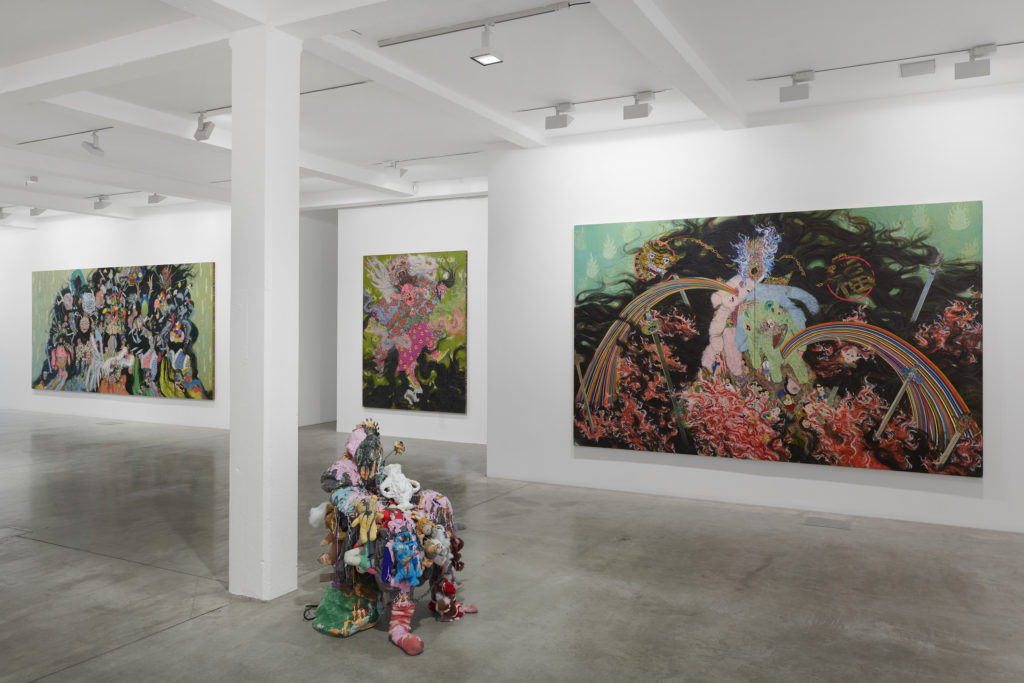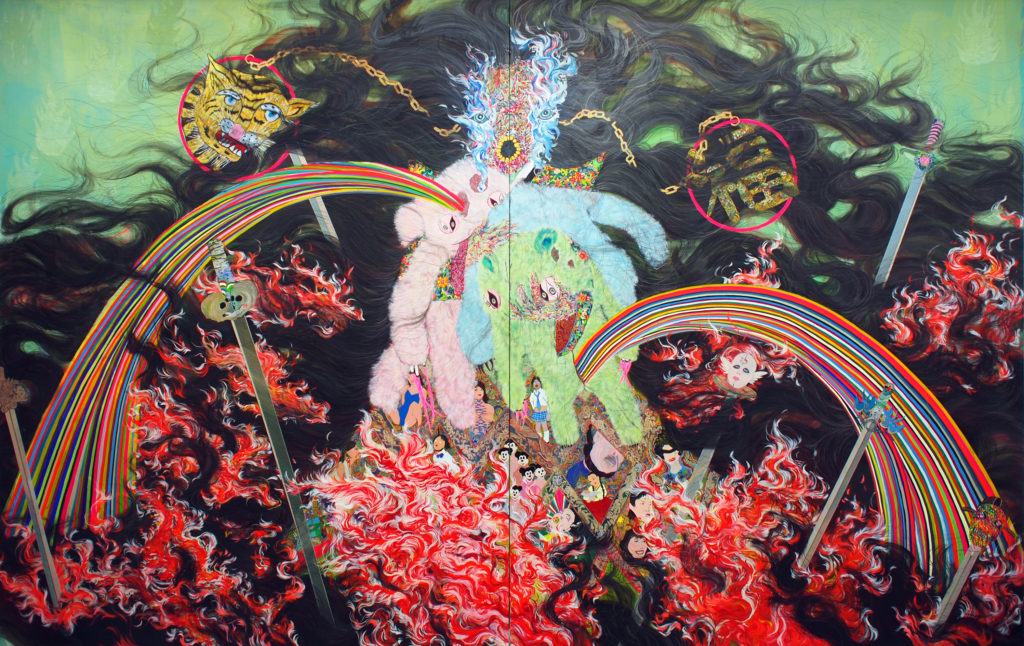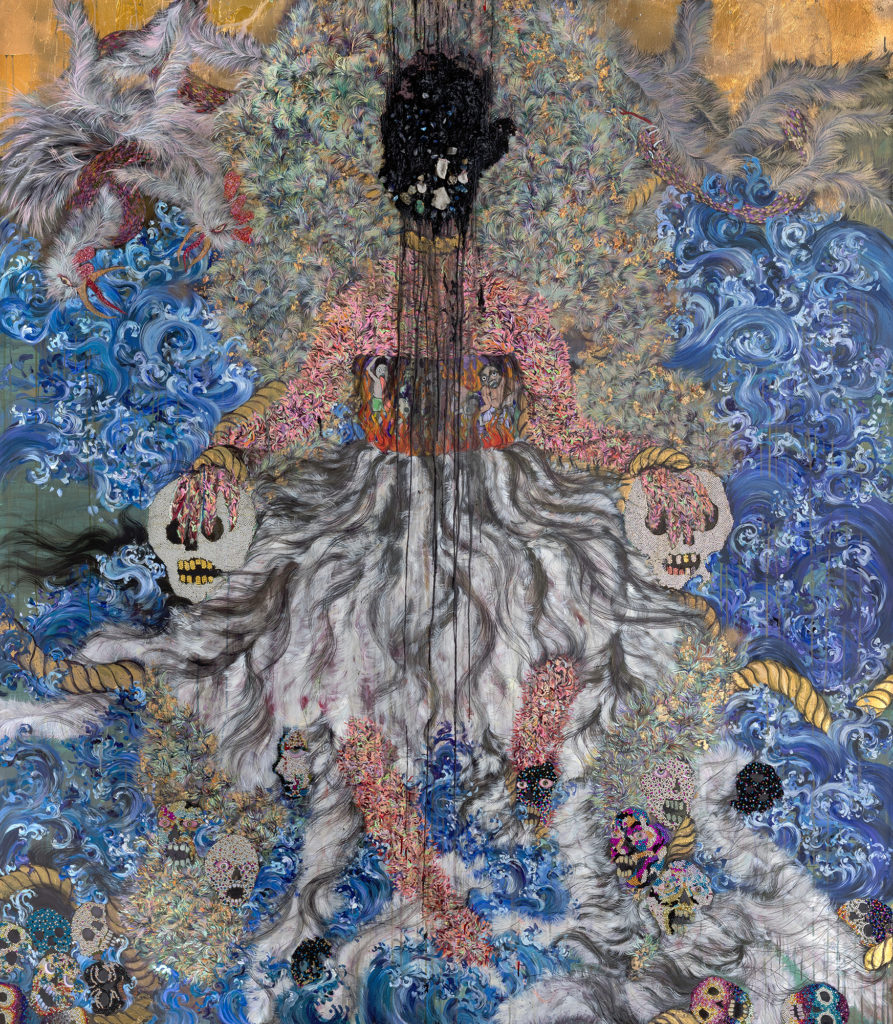An Emotional State of Mind: Hyon Gyon
by Kostas Prapoglou

The visual language of Korean born, Poland-based artist Hyon Gyon lies somewhere between contemporary expressionism and the realms of a fantasy world. Colorful and vibrant, yet dark and daunting, her sculptures, installations, and canvases reflect a turbulent esoteric world, where intense emotions and explosive energy levels are pronounced in extreme detail. Within the artist’s first solo exhibition in Europe, Parasol Unit Foundation for Contemporary Art features recent works that present Gyon’s utilization of large range of both conventional and unorthodox materials. Bringing viewers closer to her inspirations and influences, Gyon works with subjects such as Korean shamanism and the labyrinthine journeys of the subconscious.
I invited Gyon to discuss her work and the diversity of her practice—below is a transcription of our conversation, which focuses on her perception of spiritualism, as well as how the subconscious has the potential to locate ideas surrounding our corporeal and emotional experiences.
Kostas Prapoglou: How did Shamanism, spiritual healing, and magic start influencing you and the way your ideas are transmitted through your practice?
Hyon Gyon: The first time I became interested in Korean Shamanism was when my family invited a Shaman to our house after my grandmother passed away. The ceremony was held to comfort and cleanse her spirit, and I was both moved and fascinated by the ceremony itself; people were laughing, crying, and playing musical instruments for two to three hours. Seeing the Shaman perform her rituals shaped my imagination and convinced me that my grandmother had made peace with this world, restoring our faith that her spirit would have a happy afterlife. During the ceremony, I felt a wave of uncomfortable feelings towards my grandmother—guilt, regret, dark and ugly thoughts—that had been trapped inside me all those years. They started to move through and out of my body, turning into other forms of energy. It is really difficult to describe those emotions, which was a physically and spiritually shocking experience for me. Those feelings are very hard to define, but it was certainly cathartic. Ultimately, the ceremony was for the people left in this world, and part of the healing process was for the living ones. The only reason Shaman and Shamanism still exist in the twenty-first-century is because of the fact that they have been involved in all of the most basic human emotions and phases of people’s lives—from triumphs and tragedies, to birth and death. The most attractive part of Shamanism is that it affects the negative parts of life, such as sadness, death, disease, hatred, or jealousy. And it was the closest thing ever to the ‘fundamental power of art’ that I have ever pursued.
KP: To what degree do you believe that art is able to contribute towards psychotherapy, and how does this translate through your own modus operandi?
HG: When I begin creating a work, the healing or cleansing process unfolds, whether I want it to or not, but that is not a goal I set. I believe that art is able to contribute to psychotherapy in one way or another. Sometimes my personal life or my feelings at that time are directly projected onto my artwork, and I often find myself discovering unknown sides of myself. Mostly, I find myself confronted by deep-seated violence, anger, resentment, sorrow, disappointment, depression, and fear that I did not even know existed within me. These ‘taboo’ emotions might become lost inside me and end up attacking me—instead, I find it important to understand myself and accept my inner, dark emotions rather than ignore them. It is not easy, because I become aware of the cruelty of the world in which we live, and I lose hope again. In the end, the cathartic feeling I experience always gives me hope.

KP: Your work engages a vast range of materials, from paint to cement and nylon. Does the material selection process depend on your chosen narrative or the emotional state you are in each time?
HG: I pay attention to things that surround me: things I eat, people I meet, things I see, and things I wear, to see if I can connect them with my work. So, I believe that everything that surrounds me carries the potential to be used as material, but I do not particularly start with a certain narrative or concept when I begin the selection. When I either spend long amounts of time in front of a canvas, or I am meticulously painting, certain agonies and worries enter my mind, asking me to repent my faults—every piece of memory appears randomly and disturbs me. When I reach that point, I suddenly switch from using a brush to using my hands and fists, start to grab my clothes, toys, underwear, and hammers instead of using tools for painting. Anything around me can be used as a sacrifice in my work; tires, blankets, pajamas, socks, tapes. Anything can actually be used, torn, or disastrously burnt instead of just painting with paints. I have never tried to anticipate the direction of my work; I just know what materials to choose and how to use them instinctively. I just let it happen.
KP: I detect a pronounced performative element in your practice. Is this something you control, or does it emerge instinctively?

HG: Once I get into an emotional state of mind, I lose control. It is impossible to describe. I just know what I have to do right in that moment. Once I enter into this trance-like state, my body is transformed into a medium that expresses my anger and desire, sorrow and sympathy, or sexual pleasure and violent attitudes. Sometimes I cry, or I laugh, and sometimes I hit—there is no time to think why. I guess, unconsciously, I undergo a primitive version of the psychoanalytic cathartic method. I try to reach in and take out something inside me—that is why it is necessary to use my whole body to shake and wake myself, bringing out the performative element in my work.
KP: How is your art perceived by audiences in different parts of the world? Are your references to Korean and Asian philosophy easily interpreted in diverse sociocultural environments?
HG: Everyone has different attitudes towards art, and I also think that there are differences in how cultural environments shape our opinions or feelings. For instance, I have never seen any Korean or Japanese people showing intense emotions towards my work. Yet, in the United States, I see people react very emotionally while viewing my work—some even cried during the exhibition. People express their emotions in different ways and, depending on their social environment and culture, they will interpret or react to my work in various ways. In Korea and Japan, I think it is considered a virtue not to express your feelings and emotions (whether it is sorrow or even pleasure). Once my art is displayed and open to the public, my work is done. From there, it makes its own way.
Hyon Gyon at Parasol Unit ran from January 3—March 31, 2019.